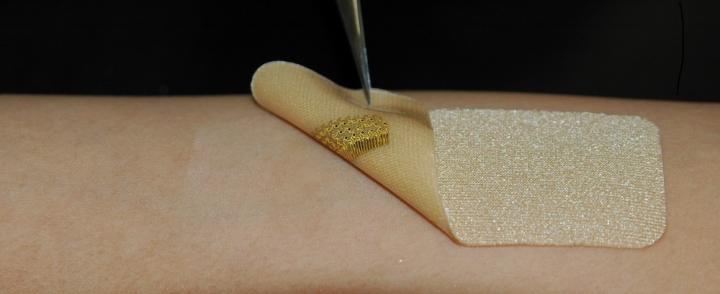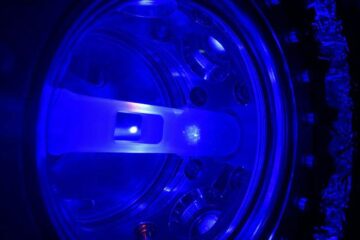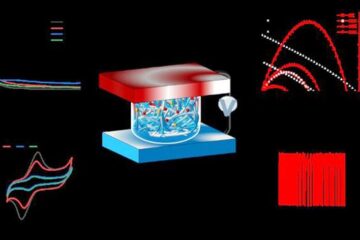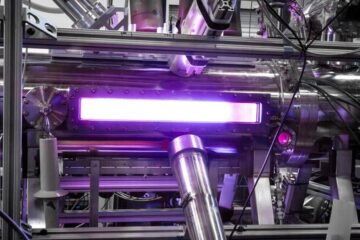Wearable sensors mimic skin to help with wound healing process

This is an image of the sensor on a textile-silicon bandage. Credit: Matthew Brown
“We eventually hope that these sensors and engineering accomplishments can help advance healthcare applications and provide a better quantitative understanding in disease progression, wound care, general health, fitness monitoring and more,” said Matthew Brown, a PhD student at Binghamton University.
Biosensors are analytical devices that combine a biological component with a physiochemical detector to observe and analyze a chemical substance and its reaction in the body. Conventional biosensor technology, while a great advancement in the medical field, still has limitations to overcome and improvements to be made to enhance their functionality.
Researchers at Binghamton University's Intimately Bio-Integrated Biosensors lab have developed a skin-inspired, open-mesh electromechanical sensor that is capable of monitoring lactate and oxygen on the skin.
“We are focused on developing next-generation platforms that can integrate with biological tissue (e.g. skin, neural and cardiac tissue),” said Brown. Under the guidance of Assistant Professor of Biomedical Engineering Ahyeon Koh, Brown, master's students Brandon Ashely and Youjoong Park, and undergraduate student Sally Kuan designed a sensor that is structured similarly to that of the skin's micro architecture.
This wearable sensor is equipped with gold sensor cables capable of exhibiting similar mechanics to that of skin elasticity.
The researchers hope to create a new mode of sensor that will meld seamlessly with the wearer's body to maximize body analysis to help understand chemical and physiological information.
“This topic was interesting to us because we were very interested in real-time, on-site evaluation of wound healing progress in a near future,” said Brown. “Both lactate and oxygen are critical biomarkers to access wound-healing progression.”
They hope that future research will utilize this skin-inspired sensor design to incorporate more biomarkers and create even more multifunctional sensors to help with wound healing. They hope to see these sensors being developed incorporated into internal organs to gain an increased understanding about the diseases that affect these organs and the human body.
“The bio-mimicry structured sensor platform allows free mass transfer between biological tissue and bio-interfaced electronics,” said Koh. “Therefore, this intimately bio-integrated sensing system is capable of determining critical biochemical events while being invisible to the biological system or not evoking an inflammatory response.”
###
The paper, “Skin-inspired, Open Mesh Electrochemical Sensors for Lactate and Oxygen Monitoring,” was published in Biosensors and Bioelectronics.
Media Contact
More Information:
http://dx.doi.org/10.1016/j.bios.2019.02.041All latest news from the category: Life Sciences and Chemistry
Articles and reports from the Life Sciences and chemistry area deal with applied and basic research into modern biology, chemistry and human medicine.
Valuable information can be found on a range of life sciences fields including bacteriology, biochemistry, bionics, bioinformatics, biophysics, biotechnology, genetics, geobotany, human biology, marine biology, microbiology, molecular biology, cellular biology, zoology, bioinorganic chemistry, microchemistry and environmental chemistry.
Newest articles

Superradiant atoms could push the boundaries of how precisely time can be measured
Superradiant atoms can help us measure time more precisely than ever. In a new study, researchers from the University of Copenhagen present a new method for measuring the time interval,…

Ion thermoelectric conversion devices for near room temperature
The electrode sheet of the thermoelectric device consists of ionic hydrogel, which is sandwiched between the electrodes to form, and the Prussian blue on the electrode undergoes a redox reaction…

Zap Energy achieves 37-million-degree temperatures in a compact device
New publication reports record electron temperatures for a small-scale, sheared-flow-stabilized Z-pinch fusion device. In the nine decades since humans first produced fusion reactions, only a few fusion technologies have demonstrated…





















